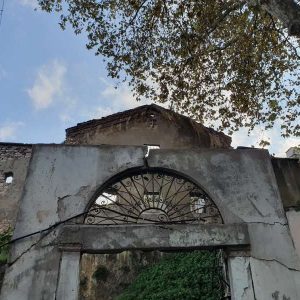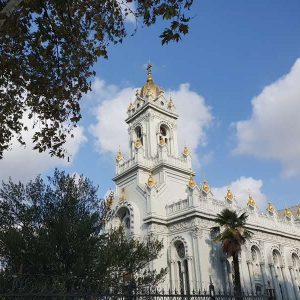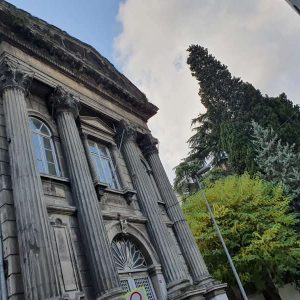Next year in Fener
From the Pera Palace Hotel, I descend the steep streets of Istanbul’s Pera district towards the shores of the Golden Horn, not far from the place where a chain was put during Byzantium that was supposed to prevent the ships of the invaders from approaching Constantinople. The chain did little to help in 1204 when the Crusaders conquered and looted the city, or in 1453 when it finally fell into the hands of the Ottomans. Parts of that legendary chain are exhibited today in the Maritime Museum on the shores of the Bosphorus, not far from Dolmabahçe Palace, as well as in Galata Tower.
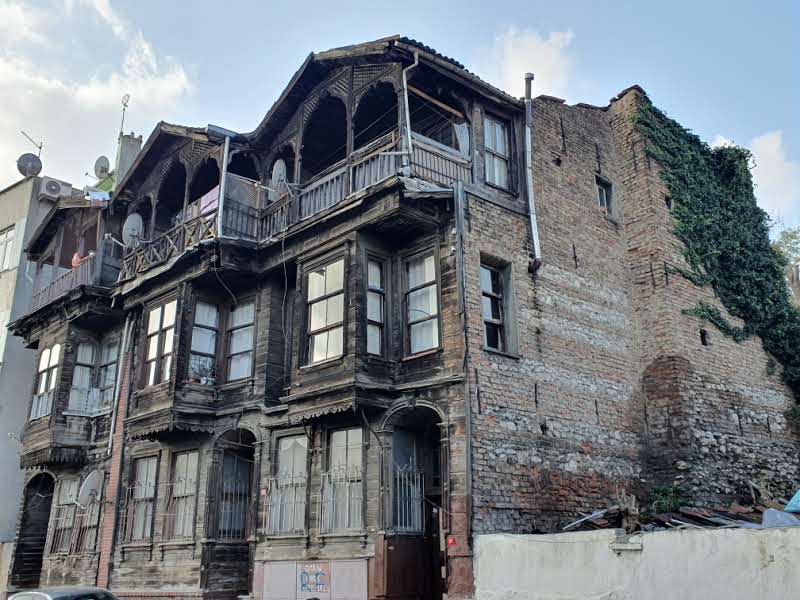
RUINS: Abandoned Church of Saint Mary of Consolation in Fener
The next boat that is supposed to take me to the other side of the Golden Horn leaves in an hour, but the local boatman Murat offers to take me to Fener for 40 lira, which is about 4 euro. We cross the smooth waters of the bay towards Fener, the Greek quarter of Istanbul where several surviving Orthodox churches testify to who made up the majority of the population in this part of the city until just 70 years ago. I jump ashore from Murat’s boat and we agree that he will wait for me for an hour and then take me back to the Pera for the same price. On the right side shines the Bulgarian church dedicated to St. Stephen.
Also known as the Bulgarian Steel Church which was built from a metal structure delivered from Vienna across the Danube and the Black Sea. The Vienna-based company, R. Ph. Wagner made the steel parts of the skeleton of the church weighing 500 tonnes from 1893 to 1896. The church, built in a mixture of neo-baroque and neo-gothic style, was completed and consecrated in 1898 and is still in the service of the small Bulgarian community in Istanbul.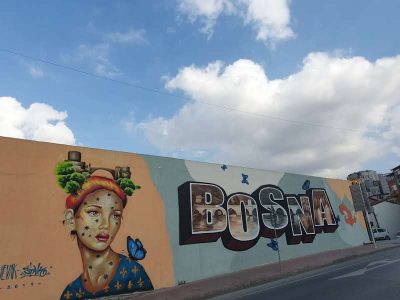
This is one of the “steel churches” that the British Empire made and sent to its distant colonies in the 19th century, all the way to Australia. Gustave Eiffel designed several such temples that ended in the Philippines and Peru. On the occasion of 120 years since its construction, after an extensive renovation, Turkish President, Recep Tayyip Erdogan, and Bulgarian Prime Minister, Boyko Borisov visited the St. Stephen Church together in 2018. The Fener district in Istanbul, once mostly Greek, today preserves the remnants of the ancient glory of Byzantium. Orthodox people lived here after the fall of Constantinople in 1453. The only Byzantine church that has never been converted into a mosque is the Church of Saint Mary of the Mongols. In his book “The Fall of Constantinople 1453”, Steven Runciman, cites sources from that time who say that streams of blood flowed through the steep street next to this church for days after May 29, 1453. Some Orthodox churches, such as the Church of Saint Mary of Consolation, are today in ruins and overgrown with vegetation.
ISTANBUL GREEKS: FROM 31% TO UNDER 0.2% IN ONE CENTURY
Only a small number of Greeks who survived 1453, the Greco-Turkish war and the exchange of population in the early 1920S and the pogrom of 1955 live in these streets today. It is incredible to see that a mosque was built next to each of the churches to, I can only guess, mark the territory and make it known to the remaining Orthodox population on whose land they are located.
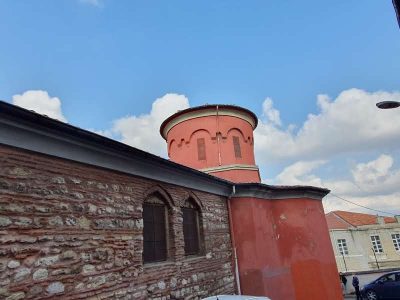
The reason that the Church of Saint Mary of the Mongols was never converted into an Islamic place of worship lies in the fact that Mehmed II the Conqueror gave it to the mother of Christodoulos, the architect who built the Fatih mosque for him. Bayezid II approved that Christodoulos’ son should inherit this gift. The next few sultans wanted to turn this church into a mosque, but it was not possible against the ferman (oath) of the conqueror of Constantinople. A copy of the mentioned decree of the greatest Turkish sultan is still exhibited on one of the walls of the church.
The life of the only spared Byzantine church in Istanbul was not easy even during the era of the Turkish Republic. Namely, the church was ruined in the so-called Istanbul pogrom in 1955, when almost all Greeks from the city were annihilated. Turkish authorities first staged a bomb attack on their consulate in Thessaloniki and then orchestrated a “spontaneous” reaction from the Turks in Istanbul. The city’s lowlife, aided by “like-minded people” brought in by buses from all over Turkey, were deployed around the city and given instructions to attack the last Greeks of Constantinople.
Along with the Greeks, other Christians also perished including the Armenians, Georgians and Jews. An enraged mob stormed their apartments and houses, looted shops, set fire to and destroyed their property. There is a photograph of Istiklal Street, which was full of scattered and broken Christian things. The scene is almost identical to the Night of Broken Glass in Germany in 1928. Murders took place, many women were raped, and cases of forced circumcision were also recorded, including on a priest. The data show that in 1919, as many as 31% of the population who declared themselves as Greeks lived in Istanbul. Five years later, after the Greco-Turkish War, that number dropped to 19% and after the pogrom of 1955, it declined from about 5% to below 0.2% today.
MIDNIGHT AT THE PERA PALACE HOTEL
The atmosphere of multiethnic Istanbul, as it was in the mid-1920s, is described by the American author George King in his book “Midnight at the Pera Palace Hotel: The Birth of Modern Istanbul”. At midnight, on December 31, 1925, the citizens of the newly proclaimed Turkish Republic are celebrating New Year’s Eve, for the first time ever, in line with the Western calendar and time. Istanbul, the crossroads between East and West, is home to generations of Turks, Greeks, Armenians, Jews, and as of recently, the White Russians, who fled the October Revolution. There are Bolshevik assassins, Trotsky, German professors, spies, British diplomats and American businessmen. All of them are eagerly waiting for the New Year of 1926 in the most luxurious hotel called the Pera Palace in Istanbul. The novel will be screened soon and we will be able to watch it on Netflix as an 8-episode-series. The hotel is, by the way, one of those where each wall tells history. It was built in 1892 for passengers of the Orient Experts, and it was inhabited by Ataturk (memorial room still exists at the hotel), Agatha Christie, Ernest Hemingway and in 1940, Josip Broz, a communist activist with a refined taste for luxury. Ilham Gencer, a 94-year-old Turkish pop star, plays the piano here every Friday and Saturday from three to six in the afternoon.
On October 30, the first Muslim prayer was held in Chora, which reverted to its name it bore as a mosque – Karia
While wearing a face mask (Istanbul has high penalties for not wearing one), I continue to climb the steep streets of Fener to check the information about the scandalous “reconstruction” of the Church of the Holy Saviour, known as Chora. This Byzantine place of worship from the 5th century, which is considered one of the most valuable temples from the time of the Palaeologus, became a mosque in 1453 when its precious icons were painted over. After a ten-year restoration, just like in the Yugoslav movie “A Time of Miracles”, the icons started showing again under a thick layer of lime. In 1958, the Turkish Republic gave it the status of a museum, like Hagia Sophia.A few months ago, the world was shocked to find out that the icons were painted over again and Chora was no longer a museum but a mosque again. On October 30, the first Muslim prayer was held in Chora, which reverted to its name it bore as a mosque – Karia.
I could not see that in person because the paths leading to the church were blocked by construction fences bearing information on how the building is in the process of restoration.
As I was leaving, a bagel seller next to the church approached the fence through which a small Muslim cemetery can be seen in the church gate, raised his hands with his palms facing him and began to say a prayer.
I am going down to the Ecumenical Patriarchate in the part of Fener just off the coast of the Golden Horn. I pass small restaurants and cafes that used to be full of tourists. Today, locals occupy them and unlike many similar tourist districts in other parts of Europe, this area still seems very lively.
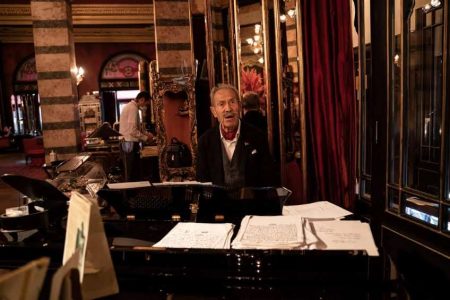
WHAT THE CRUISERS STOLE, THE POPE RETURNED
There is strong security at the entrance to the Patriarchal Church, a consequence of the bomb attacks from 1993 and 2004. Visitors are only allowed to enter during service. Disappointed, I go down to the shore and meet a priest. I tell him that I am from Serbia and ask him if I can see the inside of the Patriarchal Church. He takes a Motorola out of his pocket and calls the security guards who are standing twenty metres away to let me look inside the temple. While we were greeting each other, he says that he is from Thessaloniki and that Greeks and Serbs are brothers.
I go through a security detail and enter the port of the Cathedral Church of St. George from 1600. The bones of two saints – St. Gregory of Nazianzus and St. John Chrysostom – which were looted by the Crusaders in 1204, were returned to the Cathedral by Pope John Paul II, exactly eight centuries later, in 2004. A gruesome episode from the turbulent history of the Greeks in the Ottoman Empire took place right here. In 1821, Sultan Mahmud II, dissatisfied with Patriarch George V’s stance during the Greek uprising, ordered for the Patriarch to be killed and that his body should hang for three days at the Patriarchate’s entrance.
I return to the port of Fener where Murat is waiting for me with his boat. Climbing back to the Pera Palace Hotel, I pass by a large mural that reads “Bosnia” and the letters depict a visit to the Drina Bridge, built in 1577 by Mehmed Pasha Sokolovic, and celebrated by a Nobel laureate, Ivo Andrić, almost four centuries later. Kosovo, to which we are going to return ‘next year’ if we were to believe the messages on the Belgrade murals, is called ‘Bosnia’ on the wall of a Renault car service shop in Istanbul.
